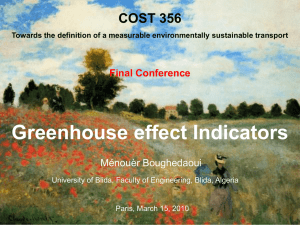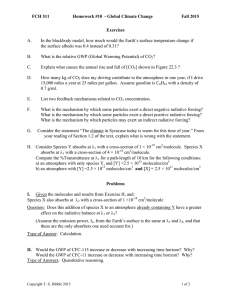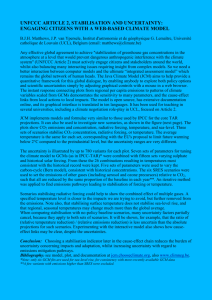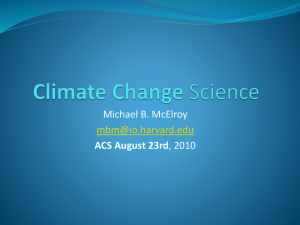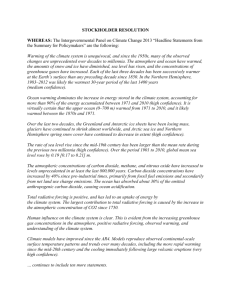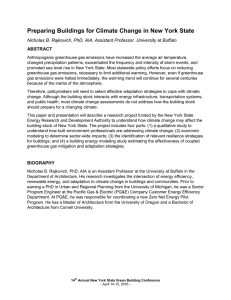Comparing the Effects of Greenhouse Gas Emissions on S. 1990
advertisement
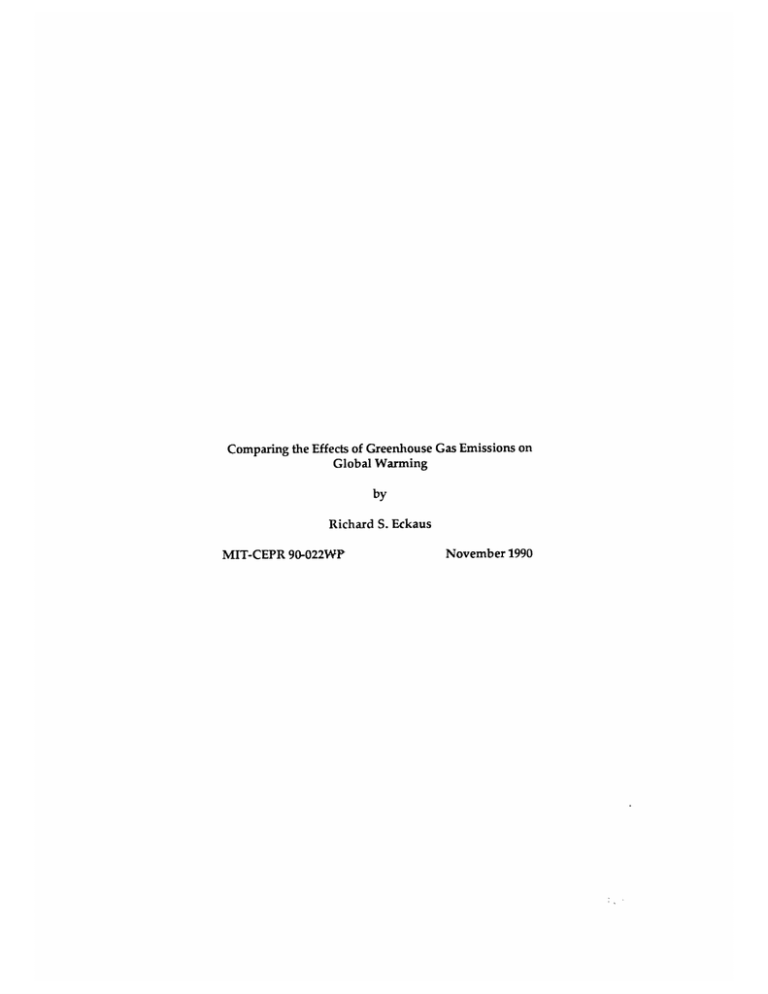
Comparing the Effects of Greenhouse Gas Emissions on
Global Warming
by
Richard S. Eckaus
MIT-CEPR 90-022WP
November 1990
COMPARING THE EFFECTS OF GREENHOUSE GAS EMISSIONS
ON GLOBAL WARMING
Richard S. Eckaus
Professor of Economics
Department of Economics
Center for Energy Policy Research
Program in Science and Policy
in Global Change Decision-Making
M.I.T.
Nov. 23, 1990
* Without implicating them in any way, the author wishes to acknowledge
the comments of Henry Jacoby, Robert Solow, David Victor and David Wood.
eh
0
ABSTRACT
Policies dealing with global warming require a measure of the effects of the
emissions of greenhouse gases that create different magnitudes of instantaneous
radiative forcing and have different lifetimes. The Global Warming Potential
(GWP), a physical index of the total radiative forcing due to an emission of a unit
amount of a particular greenhouse gas has been proposed by the Intergovernmental Panel on Climate Change as a such a policy tool. In general, no such
physical index will serve this purpose. Adding up physical measures of radiative
forcing in different periods resulting from emissions at different times and places
is, in an economic and policy sense, like adding apples and oranges.
Discounting
of radiative forcing in successive periods, as in done in some versions of the GWP,
is only an arbitrary weighting.
Reduction of radiative forcing effects in different future periods of greenhouse gas emissions that occur at different times and places can be expected to
impose different economic costs. These opportunity cost valuations must be used
to weight the effects of a greenhouse gas emission over its lifetime. That leads to
the concept of the Emissions Opportunity Cost (EOC) of a greenhouse gas emission. While this is more difficult to measure, it is the essential guide to policy.
I.
Introduction
The formulation of policies to deal with global warming requires a measure
of the effects of the emissions of greenhouse gases that create different
magnitudes of instantaneous radiative forcing and have different lifetimes. The
Global Warming Potential (GWP), a physical index of the total radiative forcing
due to an emission of a unit amount of a particular greenhouse gas has been
proposed by the Intergovernmental Panel on Climate Change as a such a policy
tool. 1 According to the IPCC, the GWP would help, "in considering policy
options," which, presumably, would include economic evaluations of the
consequences of limiting emissions, tax policies, trade in gas emissions
"permits" and, perhaps, allocation of international emissions quotas. 2 The GWP
is an extension of the concept of Ozone Depletion Potential (ODP) developed in the
discussion of controlling the emissions of halocarbons. The ODP became an
essential part of the Montreal Protocol agreement for controlling the emissions of
these gases. 3 So the concept deserves careful scrutiny and has already generated
an extensive discussion of its scientific rationale. 4
It will be argued here that, in general, no such physical index will serve the
purposes suggested by the IPCC. Reduction of radiative forcing effects in different
future periods of greenhouse gas emissions that occur at different times and
1 J.T.
Houghton, G.J. Jenkins and J.J. Ephraums, Climate Change. The IPCC Scientific
Assessment, Cambridge U. Press, Cambridge, 1990, p. 58.
2 J.T.
Houghton, G.J. Jenkins and J.J. Ephraums, op.cit., p. 58.
Houghton, G.J. Jenkins and J.J. Ephraums, op.cit., p. 2; Donald J. Wuebbles, "The Relative
Efficiency of A Number of Halocarbons for Destroying Stratospheric Ozone," Lawrence
Livermore Laboratory, Jan., 1981 (unpublished).
3J.T.
Daniel A. Lashof and Dilip R. Ahuja, "Relative contributions of greenhouse gas emissions
to global warming," Nature, 344, 5 April, 1990, pp. 529-531, Kirk R. Smith and Dilip R. Ahuja,
"Toward A Greenhouse Equivalence Index: The Total Exposure Analogy," Climatic Change,
4 E.g.
August, 1990, 17:1-7.
places can be expected to impose different economic costs. These cost valuations
must be used to weight the effects of a greenhouse gas emission over its lifetime.
By not ascribing economic weights to the radiative forcing of a gas emission in
successive periods, the GWP, in effect, gives the effects equal economic weight,
regardless of the period in which they occur and their sources. This would be
true, however, only under very special economic conditions. While some versions
of the GWP discount the radiative forcing in successive periods, such discounting,
in these circumstances, is an arbitrary weighting that does not resolve the
essential economic issue.
II.
The Global Warming Potential and the Economic Opportunity Costs of
Preventing Global Warming
The Global Warming Potential index integrates the radiative forcing due to
a unit of a particular greenhouse gas emission over its residence time in the
atmosphere and normalizes that sum by a corresponding integral for carbon
dioxide. Using the notation of Lashof and Ahuja, GWP is defined as:
oai(t) ci (t) dt
GWP =
(1)
ac (t)cc (t) dt
where ai(t) is the instantaneous radiative forcing due to a unit
increase in the concentration of gas i, and ci(t) is the fraction of gas i
remaining at time t. The corresponding values for CO 2 are in the
denominator. 5
There are a number of issues of atmospheric chemistry in this definition
that are the subject of continuing scientific debate, for example, the lifetimes over
5opcit., p. 529.
which the integrals should be defined. These issues will be passed over here as
not essential for the points that will be made.
The essential economic concept for policy purposes is that of the opportunity
cost of reducing radiative forcing. The "opportunity costs" of emissions reduction
are the additional direct and indirect real expenses required, for example, in
reducing energy losses or using more expensive, but less polluting electricity
generating processes. High opportunity cost producers, by purchasing emissions
permits from low opportunity cost emitters, would compensate the latter for
assuming the burden of emissions reduction. Or taxes applied to consumers
should be designed to reflect the opportunity costs to consumers of foregoing
consumption that generate polluting greenhouse gases. These opportunity costs
are also known among economists as, "shadow prices," with the word "shadow"
reflecting the fact that they are not necessarily the prices that prevail in markets.
The reduction of radiative forcing in some future period imposes
opportunity costs in every prior period. However, those opportunity costs can be
expected to vary from period to period. The total opportunity costs of an emission
in the current period are the sum of the opportunity costs created by radiative
forcing in each successive period. The GWP index cannot be used to approximate
those opportunity costs by multiplying it by a single price or cost value.
By adding together the successive radiative forcing effects, without valuing
these effects, the GWP index implicitly sets equal the current opportunity cost
valuations of the radiative forcing in each future period. That would permit them
to be factored out of the GWP definition. Yet there is no valid economic reason
why these opportunity costs should be equal. It would be true in some kinds of
economic steady state, but economic steady states, while a useful theoretical
concept, are no more likely to prevail in the future, than in the past. Nor is there
any reason to believe that the steady state conditions for different countries would
generate the same opportunity cost weights.
William Nordhaus 6 and then Lashof and Ahuja 7 proposed applying a
constant discount rate to future radiative forcing in order to, "account for the fact
that the damage from warming would differ depending on exactly when the
warming occurred." 8 This does recognize the differing economic significance of
radiative forcing at different points of time in the future, which must be reflected
in present evaluations. Yet, it is an inadequate recognition because there is no
reason why the economic evaluations of radiative forcing in successive periods
should decline at exactly the rate of discount.
Unfortunately, therefore, the GWP is a concept that cannot, in fact, achieve
the goal for which it is intended: "to address policy questions regarding the
relative amounts of rational expenditures on different mitigating strategies," and,
"develop cost-effective emissions policies at both national and international
levels."9
In place of the GWP what is needed is a concept in which the radiative
forcing in each period is valued by multiplying it by an associated opportunity cost
or shadow price. The concept that does this is defined in equation (2) and might be
called the Emissions Opportunity Cost (EOC) of a greenhouse gas emission:
EOCi =
J
6 "Contribution
vi(t) ai(t) ci(t) dt
of Different Greenhouse Gases to Global Warming: A New Technique for
Measuring Impact," (unpublished), Feb. 11, 1990, p. 3.
7op.cit., p. 531.
8W.
Nordhaus, on.cit., p. 3.
9o..cit., p. 531.
(2)-
In this definition, the a's and the c's have the same meaning as in the
definition of GWP in equation (1). The vi(t)'s in this equation represent the
current opportunity costs to the economy as a whole, per unit of the gas, of not
generating this particular radiative forcing. Thus the EOC concept reflects the
instantaneous forcing effects of an emission, the emission's atmospheric lifetime
and the opportunity costs of eliminating the radiative forcing. It would be possible
to normalize this by relating it to the opportunity cost of not allowing the emission
of the same quantity of carbon dioxide to have taken place, but there would be no
particular usefulness to doing so.
The only, but very significant, difference between the EOC and GWP
concepts are the vi(t)'s, the opportunity cost valuations in the current period of the
radiative forcing in each future period. Multiplying the ai(t) ci(t) products by a
cost converts them into values that can be added up. Adding up physical
measures of radiative forcing in different periods resulting from emissions at
different times and places is, in an economic and policy sense, like adding apples
and oranges. That cannot be done, but adding values of apples and oranges is
legitimate.
III.
A Simple Model of the Economic Effects of Constraining Greenhouse Gas
Emissions
A simple model may help to illustrate the difficulties. It will be formulated
as a linear programming problem in order to take advantage of the immediate
demonstration that method provides of the valuations of all the relevant variables.
This formulation will also provide a connection to the programming models that
have been formulated to analyze the economic impacts of emissions constraints. 10
1 0 See
Nordhaus, William, "Economic Growth and Climate: The Carbon Dioxide Problem,"
American Economic Review. Papers and Proceedings, 67 (1), 341-346; Manne, Alan and Richels,
Richard G., "C02 Emission LImits: An Economic Analysis for the USA," presented at the MIT
Workshop on Energy and Environmental Modeling, July 31-Aug. 1, 1989; Blitzer, Charles R.,
The linear programming formulation should not, however, be interpreted as
overlooking the many non-linearities in production and consumption, as well as
in the generation and accumulation of greenhouse gases, but rather as only an
easier way of making a few general points, than is possible in a nonlinear
dynamic programming formulation.
The representation of the economy can be simplified enormously if it is
thought of as if producing only one good, the gross national product. Equivalently,
however, the single good may be considered a set of goods, although that would
only add detail that is not essential for the present purposes. There will, however,
be two greenhouse gases, one of which could be thought of as carbon dioxide,
although that, too, is not essential for the demonstration.
The issues that have been raised as to the time over which future effects of
emissions should be integrated will be finessed here as not related to the major
point being made. The time horizon will be arbitrarily truncated at only three
time periods in this model, which are themselves arbitrary and may be
considered to be one year, 20 years, roughly the length of a generation, or 100
years. The alternatives would only require different definitions of the parameters
to reflect the process of averaging over different periods. l l It is obvious that this
truncation of the future does not capture the long lifetime of some of the
greenhouse gases. However, for the present purposes of demonstrating the
necessity of considering the economic opportunity costs of emissions, the future
need not stretch very far.
Eckaus, Richard S., Lahiri, Supriya and Meeraus, Alex, "A General Equilibrium Analysis of the
Effects of Carbon Emissions Restrictions on Economic Growth in A Developing Country," Center
for Energy Policy Research, MIT, Cambridge, Mass., July, 1989 (unpublished).
1 1 The
parametrization of the relation between annual investment and the change in capital stock
would be different for one year periods from that for, say, 20 years.
For simplicity the model will represent a closed economy and one without a
government sector. Output in each period will depend only on the capital stock
available and on intermediate inputs through fixed ratios. Labor requirements
will be ignored.
The first constraint of the model states the truism that an economy cannot
use more of anything than it has available. The total availabilities from domestic
production are X(t) and the uses of output are for: consumption, C(t), investment,
I(t), and intermediate inputs, zX(t). Since intermediate requirements are related
to output by a parameter, or, for many goods, a matrix of parameters, z, for each
period the constraint can be written:
C(t) + I(t) + zX(t) < X(t). 12
(3)
Since production depends on capital, there is a constraint for each period
that requires that production in any period must be less than the productive
capacity of the capital stock available at the beginning of the period, K(t). The
capital capacity requirements are determined by an capital/output coefficient, b so
that:
b X(t)- K(t)0
.
(4)
There is an initial capital endowment K(1). After that capital accumulates
from investment and depreciation of capital will be neglected. Thus, the capital
accumulation processes in the second and third period are:
K(2) < K(1) + I(1) or
K(2) - I(1)
K(3) < K(1) + I(1) + I(2) or
K(1) .
K(3) - I(1) - 1(2)
(5)
K(1) .
(6)
It is also necessary to specify a terminal condition, otherwise there would
be no reason for investment in the last period. A convenient way of doing that is
1 2 If
the model is interpreted as representing many goods, so each variable presented is really a
vector, then some means must be provided of disaggregating each of the uses of output, C(t) and I(t).
It will be simply assumed here that could be done, if desired; by a set of linear relations.
simply to require that the last period's investment be enough to provide for growth
in the capital stock from the last period to the post-terminal period. Since the
capital stock in the last period is K(1) + I(1) + 1(2), if g is the specified capital stock
growth rate,
I(3) = g[ K(1) + I(1) + I(2)]
.
(7)
This specification of 1(3) can be substituted into the inequality (3) for the third
period.
To compute the radiative forcing in a particular period due only to the
emission of the two greenhouse gases in that period, it is necessary to multiply the
level of the emitting activity, considered here to be the production of the single
good, X(t), by the emission rates, ei, and then apply the instantaneous radiative
forcing coefficients, ai. 13 Both of these rates can be assumed to be constant
without damage to the argument. For example, if R1 (1) is the additional radiative
forcing in the first period, due to emissions in the same period:
R 1 (1) = (al el + a 2 e2) X(1).14
(8)
The radiative forcing in successive periods due to the greenhouse gas
emissions in the first period has to be adjusted to account for the elimination of
the gases from the atmosphere. For simplicity it will be assumed that the
fractions dl and d 2 of the two gases "disappear" in each period and that these
fractions are constant over time. Again these assumptions do not affect the main
points of the argument. Thus the radiative forcing in period 2 due to the
emissions in period 1 is
13 This
1 4 This
adopts the notation of D.A. Lashof and D.R. Ahuja, op.cit.
formulation is recognized to be a gross oversimplification of the atmospheric chemistry.
However, it is believed that the simplications do not negate the central argument.
R 1 (2) = [(aI el)(1-dl) + (a2 e 2 )(1-d 2 )] X(1) .15
(9)
Social preferences with respect to climate change will be expressed in a
simple way that does not affect the essential point of the illustration. It will be
assumed that in each period of the model there is a maximum allowable net
addition to radiative forcing, R(1), R(2) and R(3). Thus the constraint on the net
addition to the radiative forcing in the first period is
R1 (1) -R(1) < 0.
(10)
There is a similar constraint for each successive period.
A simple linear objective function will be used which is the discounted sum
of consumption during the model's time horizon 16:
1
t
C(t)/(l+w)(t-)
(11)
Although environmental conditions are not included in the objective
function but, rather, imposed as a constraint, this does not imply a judgment that
there is no utility associated with environmental conditions. This treatment
might be rationalized as a means of avoiding the difficulties involved in
discovering the relative weights that should be placed on produced consumer
goods and environmental quality. Alternatively it can be viewed as an expression
of the idea that future generations have an incontrovertible right to a specified
level of environmental quality. There could be an objection, which would be
correct, that imposition of a constraint on radiative forcing or greenhouse gas
accumulation, in effect, gives the specified, maximum allowable addition to
15The
a's have the same meaning as in the IPCC and Lashof and Ahuja definitions of the GWP
and the (1-d) terms play the same role as the c's in those definitions. The e terms, which generate
the total amount of gas associated with a particular production activity, do not appear in the GWP,
which is calculated per unit of the gas.
1 6 In
this formulation, the discount rate, w, represents consumer time preference, not the marginal
productivity of capital. It should also be noted that this is quite different from the D.A. Lashof and
D.R. Ahuja and W. Nordhaus discounting of radiative forcing.
radiative forcing an infinite weight, since the constraint must be satisfied. The
formulation can also be regarded as simply a convenient device with which to
map out the consequences of alternative constraint levels.
It should also be noted that there is no feedback in the model from
environmental conditions to production conditions. This is certainly a grave
oversimplification. To remedy it, however, would take us very far afield and not
change the conclusions.
IV.
The Value of Additions to Radiative Forcing
The tableau of the model can now be written and is presented in Table 1.
The primal problem, which is the maximization of the objective function (11), can
be read across the succeeding rows of the tableau. The dual problem, which is the
minimization of the cost of using the resources to produce a particular output,
generates conditions on the valuations of each of the variables. This dual problem
and its corresponding valuations can be read down each of the columns. To avoid
the problems created by the arbitrary initial and terminal conditions and to
highlight the general lessons provided by the model, it is useful to focus on period
2.
Like the model above, all the valuations are familiar ones, with the
exception of those that reflect the constraints on greenhouse gas emissions.
Reading down the column for X 2 , the dual relationship is:
Value of
indirect
inputs
for X2
Rental of
+ capital to
produce X2
Value in
+ period 2 of
radioactive
forcing
generated in
producing X2
Value in
+ period 3 of
radiative
forcing
generated
producing X2
-
Value = 0.
(12)
of X(2)
If we suppose that a solution to the problem has been found, then both
quantities and the dual values associated with each constraint, which are just the
Table 1
MODEL TABLEAU
Period-by-period constraints on increases in radiative forcing
by greenhouse gases #1 and #2, with emission rates el and e2,
instantaneous radiative forcing rates al and a2 and annual
decay rates dl and d 2
VARIABLES
CONSTRAINTS
Objective
Distribution
Period 1
Period 2
X(1)
I C(1)
I(1)11 K(1)II
X(2)
1
(z-1)
1
X(3)
(l+w)
11C(3) 1IK(3)I
(l+w)2
1
(z-1)
1
1
(z-1)
g
g
Perod 3
j C(2) 11(2)11 K(2) I
1
-gK(1)
Capital
Formation
1K(1)
Period 1
Period 2
-1
Period 3
-1
Capacity
Period 1
Period 2
Period 3
Radiative
Forcing
Period 1
Period 2
b
1
K(1)
-1
K(1)
-1
b-1
b
alel+a2e2
alel(1-dl)+
-1
R(1)
alel+a2e2
R(2)
a2e2(1-d 2 )
Period 3
alel(1-dl) 2 +
alel(1-dl)+
a2e2(1-d2) 2
a2e2(1-d 2 )
alel+a2e2
R(3)
economists' shadow prices, will be known. That permits us to separate unit
quantities and prices in the total values in (12). Assuming that, in fact, the
emissions constraints are binding, the inequality (12) can be rewritten, with the
following shadow prices resulting from the solution:
vz(2) is the shadow price of the intermediate inputs in period 2;
vk(2 ) is the shadow rental of capital in period 2;
Vr2( 2 ) is the shadow price of the radiative forcing in period 2 resulting
from emissions in period 2;
vr2( 3 ) is the shadow price in period 2 of radiative forcing in period 3
resulting from emissions in period 2;
vx(2) is the shadow price of output, X(2).
vz(2) + vk( 2 ) + {Vr2( 2 )[(alelX)(1-dl)]+vr2(2)[(a2 e2)(1-d2)1)
+ {vr2( 3 )[(al el)(1-dl) ]+vr2(3)[(a2 e2 X1-d 2 ) ]} = vx .
(13)
The relationship in (13) says that the shadow price of output in period 2
must cover the direct costs of producing output in period 2 plus the opportunity
costs of those emissions produced in period 2 in every period subsequent to period
2. The values, vr2( 2 ) and vr2( 3 ) correspond to the v(t)'s which appeared in the
expression for EOC above. It is only the arbitrary truncation of the model at the
end of the third period that prevents the costs of emissions in periods after period 3
from appearing in the tableau. Since the two gases are generated by the same
production process in this model, they have the same shadow price associated
with the radiative forcing of each gas. With different amounts of radiative forcing
associated with the emissions of each gas, that implies a different price on the
emissions of each gas.
For the first type of gas in this discrete, three time period model, the
analogue of the GWP used by the IPCC and Lashof and Ahuja would be the sum:
[(alel)(1-dl)] + [(al el)(1-d) ]
.
(14)
However, this sum does not appear in any valuation equation of this illustrative
model.
The related sum that does appear in equation (13) is:
vr2( 2 ) [(al elX1-dl)] + vr2( 3 ) [(al elX1-dl)]
(15)
This is the discrete, two period analogue of the definition above of the Emissions
Opportunity Cost of a particular quantity of radiative forcing, except that this is
defined for the total amount of emissions resulting from a particular production
activity and, thus, contains the e terms. By comparison, the EOC is defined per
unit of a gas.
The existence of a shadow value or opportunity cost of the emissions
depends, of course, on the greenhouse gas constraint being binding. When that
constraint is binding, it imposes a cost on the emissions in every previous period
that contribute to the binding constraint.
In some kind of economic steady state condition vr2( 2 ) and vr2( 3 ) would be
equal, and could be factored out of the term in (15). There are many reasons to
believe that neither the U.S. economy or any other economy is in a steady state nor
will move into a steady state. Nor is there any reason to believe that steady state
conditions are a reasonable approximation of those that will actually exist in the
U.S. And, finally, the steady state conditions for the U.S., even if they existed or
were used as an approximation, would not be the same for other countries,
particularly the developing countries with differing levels of income, preferences,
endowments and technologies.
In view of the controversy over discounting of future effects it may be noted
that there is no discounting of the valuations of the radiative forcing in equation
(13) or in the terms of the EOC as measured in (15). Rather than discounting, the
EOC requires an evaluation of how much society wants to avoid radiative forcing.
That is not easy to provide, but easiness is not the criterion that should be
enforced.
V.
Conclusion: The Absence of a Role for Global Warming Potential and the
Need for An Emissions Opportunity Cost
The model makes it clear that the Global Warming Potential defined at the
outset of the paper is not a satisfactory policy tool. It is possible to construct
scenarios in which emissions with the same Global Warming Potential have quite
different economic values that are not related by a multiplicative factor. As a
simple example, suppose that the constraint on additional radiative forcing was
not binding in the first period in the model above. Then, although there would be
additions to radiative forcing in the first period, the shadow price on their effects
in the first period would be zero. If, however, the constraint on additions to
radiative forcing were binding in the second period, the same emissions would
have a positive shadow price in the first period related to their radiative forcing
originating in the second period.
No easy direct analogies that might help make the point jump to mind.
However, with a small stretch of the imagination the essential point can be
related to the well-known, "tragedy of the commons." 17 This tragedy is generated
by the incentives of individual members of the village that own the commons to
increase without limit the number of animals that they graze on the common
lands. With increasing density of the animals on the land increases, the ability of
the grass to renew itself decreases. The overgrazing leads to the destruction of the
commons itself.
To make the analogy with different types of greenhouse gases, suppose that
both cattle and sheep are grazed and that, once an animal is put out for grazing
1 7 Garrett
Hardin, "The Tragedy of the Commons," Science Dec. 18, 1968, 162, pp. 1243-1248.
on the commons, it stays for its entire lifetime. As is well known, the destructive
effects of sheep on pastures is greater than that of cattle as the former shear the
grass closer to the ground.
It would be possible to calculate a Grazing Destruction Potential (GDP) that
could be measured for a cow which would be the total destructive effect measured
over its lifetime. That could be compared with a similar GDP for sheep. The
GDP's for cows and sheep would, however, not provide a guide to policy. Correct
economic policy requires the equalization of the opportunity costs of adding a cow
and sheep to the commons. These opportunity costs depend on the usefulness of
the animals to their owners as well as their grazing destruction effects. If one
objective of the village was to preserve the commons with least economic cost, and
the opportunity costs associated with the grazing destruction by cows and sheep
are different, the village could gain, overall, by refraining from adding the type of
animal for which the opportunity cost was highest.
It could be expected that these opportunity costs would change over time
and that the opportunity costs of cows and sheep would vary from village to village
- and from country to country. All of this is intuitively obvious. The analogy is
exact, however. Our intuition just does not work so well for greenhouse gas
emissions.
It should be noted that the criticisms of the GWP apply equally well to the
concept of Ozone Depletion Potential.
It might be objected that argument above makes it more difficult to
formulate policy, with valuations of the opportunity costs of radiative forcing being
necessary and those valuations changing from one period to the next and from
country to country. That objection is both correct and essential. There is no easy
way out of confronting the cost to society of reducing radiative forcing.
